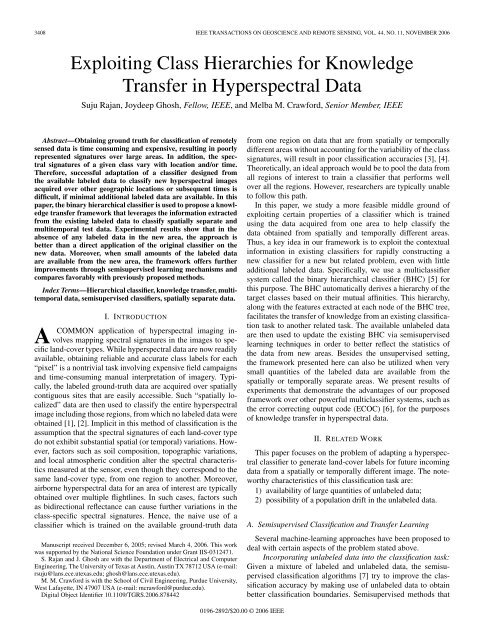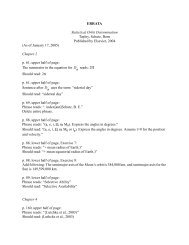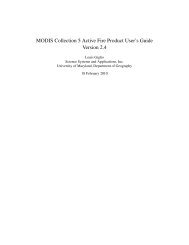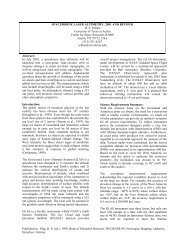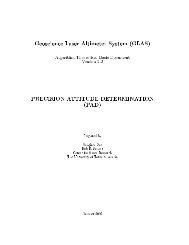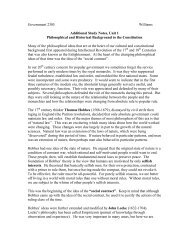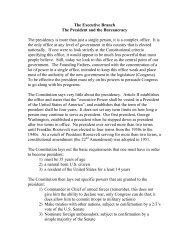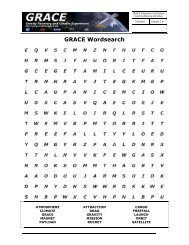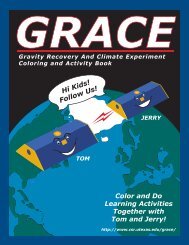Exploiting Class Hierarchies for Knowledge Transfer ... - IEEE Xplore
Exploiting Class Hierarchies for Knowledge Transfer ... - IEEE Xplore
Exploiting Class Hierarchies for Knowledge Transfer ... - IEEE Xplore
Create successful ePaper yourself
Turn your PDF publications into a flip-book with our unique Google optimized e-Paper software.
RAJAN et al.: EXPLOITING CLASS HIERARCHIES FOR KNOWLEDGE TRANSFER IN HYPERSPECTRAL DATA 3409make use of expectation maximization (EM) have met with aconsiderable success in a number of domains, especially thatof text data analysis and remote sensing. These algorithmsattempt to maximize the joint log-likelihood of both the labeledand the unlabeled data by iteratively reestimating theconditional distribution of a hidden variable, indicating the trueclass associated with the unlabeled data. It is important to notethat the standard <strong>for</strong>mulation <strong>for</strong> semisupervised classificationtechniques assumes that both the labeled and unlabeled datahave a common underlying distribution. This assumption isviolated <strong>for</strong> the application scenario considered in this paper,since it is likely that the statistics of the unlabeled data differsomewhat from that of the previously acquired labeled data, i.e.,there is a population drift [8].<strong>Class</strong>ification in the presence of population drift: Severalattempts at dealing with the problem of changing populationshave borrowed ideas from the field of online learning or incrementallearning. Most online algorithms are designed asfeedback systems. It is assumed that there is a steady streamof objects to be classified, the true labels of which are revealedimmediately after classification. Prior knowledge about the typeof the population drift (random/gradual/sudden) is then usedto update the existing classifier at regular intervals [8], [9].The online algorithms attempt to minimize the cumulativenumber of errors made, such that the resulting classifier doesnot per<strong>for</strong>m much worse than a classifier trained on the samedata in batch mode. A detailed review of several online-learningalgorithms is provided in [10].Adapting online methods to deal with the problem of populationdrift typically involves maintaining a window of theincoming training samples. At appropriate intervals, the set ofhypotheses is either retrained, or some of the outdated hypothesesare removed and replaced with those that are more consistentwith the recently seen observations [9]. While remotelysensed data obtained over extensive regions (or different times)also exhibit the problem of “population drift,” unlike the onlineframeworks, one does not have access to a streaming set oflabeled data samples.<strong>Knowledge</strong> transfer and reuse: The vast majority ofworks in machine learning and data mining focuses on solvinga specific classification task, which is isolated from other tasks.However, in practice, one is often faced by a series of (possiblyrelated) tasks, or a task whose nature changes substantially withtime. Existing techniques require large quantities of labeleddata to be able to deal effectively with the changes in aclassification task. The question then is, can one transfer theknowledge in a previously learned classifier to better tacklethe latest classification task, instead of totally reinitiating theanalysis, as is usually done?In the mid-1990s, a first generation of approaches that involvedexplicit knowledge transfer/reuse emerged, under labelssuch as “knowledge transfer,” “learning to learn,” context sensitivity/drift,and “lifelong learning” [11]–[13]. For instance,several researchers attempted to directly reuse the internal statein<strong>for</strong>mation from classifiers under the belief that related classificationtasks may benefit from common internal features. Someof the other approaches of knowledge reuse include the useof supplemental training examples or historical training in<strong>for</strong>mation,such as learning rates, reusing the labels produced byoriginal classifiers to improve the generalization per<strong>for</strong>manceon a new classifier <strong>for</strong> a different but related task, and multitasklearning neural networks that are trained simultaneously toper<strong>for</strong>m several related classification tasks.B. Semisupervised Learning and <strong>Knowledge</strong> <strong>Transfer</strong> <strong>for</strong>Remote Sensing ApplicationsThe advantages of using unlabeled data to aid the classificationprocess in the domain of remote sensing data was firstidentified and exploited by Shahshahani and Landgrebe [1].In this work, they made use of the unlabeled data via EMto obtain better estimates of class-specific parameters. It wasshown that using unlabeled data enhanced the per<strong>for</strong>manceof the maximum a posteriori probability (MAP) classifiers,especially when the dimensionality of the data approached thenumber of training samples. Subsequent extensions to the EMapproach include using “semilabeled” data in the EM iterations[14], [15]. In these methods, the available labeled data are firstused to train a supervised classifier to obtain tentative labels<strong>for</strong> the unlabeled data. Semilabeled data, thus obtained, arethen used to retrain the existing classifier, and the process isiterated until convergence. Note that these methods assume thatthe labeled and the unlabeled data are drawn from the samedistribution. In other words, the estimated class parametersare considered unreliable because of the nonavailability of thelabeled data and not because of changes in the underlying datadistribution.Besides the typical semisupervised setting, unlabeled datahave also been utilized <strong>for</strong> “partially supervised classification”[16], [17]. In partially supervised classification problems, thetraining samples are provided only <strong>for</strong> a specific class of interest,and the classifier must determine whether the unlabeleddata belong to the class of interest. While Mantero et al. [17]attempt to model the distribution of the class of interest andautomatically determine a suitable “acceptance probability,”Jeon and Landgrebe [16] make use of the unlabeled data whilelearning a maximum-likelihood (ML) classifier to determinewhether a data point is of interest or not.While all these methods deal with the data obtained from thesame image, the possibility that the class label of a pixel couldchange with time was first explored in [18]. In this work, thejoint probabilities of all possible combinations of classes betweenthe multitemporal images were estimated and used in theclassification rule. The proposed “multitemporal cascade classifier,”however requires the labeled data from all the imagesof interest. More recently, unsupervised algorithms, which canautomatically detect whether a particular pixel in multitemporalimages has changed have also been proposed [19]. Besidesalgorithms <strong>for</strong> change detection, supervised algorithms whichautomatically try to model the class transitions in multitemporalimages have also been developed [20]. Another supervisedattempt at classifying multitemporal images involves building alocal classifier <strong>for</strong> each image, the decisions of which are thencombined, either via a joint likelihood-based rule or a weightedmajority decision rule that takes into account the reliabilitiesof the data sets and that of the individual classes, to yield a“global” decision rule <strong>for</strong> the unlabeled data [21]. Similarly,other spatial-temporal methods utilize the temporal correlationof the classes between images to help improve the classificationaccuracy [22], [23].
RAJAN et al.: EXPLOITING CLASS HIERARCHIES FOR KNOWLEDGE TRANSFER IN HYPERSPECTRAL DATA 3411the node were modeled using mixtures of Gaussians, with thenumber of Gaussians corresponding to the number of classesat that node. The initial parameters of the Gaussians wereestimated using the corresponding class data from Area 1. In theE-step of the algorithm, the Gaussians were used to determinethe posterior probabilities of the Area 2 data. The probabilities,thus estimated, were then used to update the parameters ofthe Gaussians (M-step). EM iterations were per<strong>for</strong>med untilthe average change in the posterior probabilities between twoiterations was smaller than a specified threshold [3]. A newFisher feature extractor was also computed <strong>for</strong> each EM iteration,which is based on the statistics of the metaclasses at thatiteration. The updated extractor was then used to project thedata into the corresponding Fisher space prior to the estimationof the class-conditional pdfs.Analysis of the results showed that while this approachyielded somewhat higher overall classification accuracies thana direct application of the original classifier, the errors weremostly concentrated in a few classes. A closer inspection revealedthat the spectral signatures of these classes had changedsufficiently <strong>for</strong> them to be grouped differently in the BHChierarchies, if there had been adequate amounts of labeled datafrom Area 2. This suggested that we should have obtainedmultiple trees from Area 1, such that some of them would bemore suitable <strong>for</strong> the new area.Thus, our second approach was to introduce randomizationinto the structure of the BHC tree. The design space <strong>for</strong> theBHC offers many possibilities <strong>for</strong> randomizing the tree structure.In our earlier work [28], we generated randomized BHCtrees by varying factors such as the percentage of the availabletraining data, the number of features selected at each node,class priors, and by randomly switching the class labels <strong>for</strong>a small percentage of the labeled data points. In this paper,randomized BHC trees were generated by choosing an internalnode of the tree and randomly interchanging the classes drawnfrom its right and left children. The corresponding featureextractors and classifiers at that node (and its children) werethen updated to reflect the perturbation. Note that in the absenceof any labeled data from Area 2, there is no way to evaluatewhich of the randomly generated BHC trees best suits thespatially/temporally different data. Hence, we can only generatean ensemble of classifiers using the training data, hoping thatthe ensemble contains some classifiers that are better suitedto Area 2.The key to the success of an ensemble of classifiers ischoosing the classifiers that make independent errors. If theclassifiers are not independent, the ensemble might actuallyper<strong>for</strong>m worse than the best member of the ensemble. Hence, anumber of measures of diversity have been proposed to choosea good subset of classifiers [29]. Of the ten diversity measuresstudied, the authors recommend the Q av ,theρ av , and the κmeasures <strong>for</strong> their easy interpretability. They further promotethe Q-diversity measure because of its relationship with themajority vote of an ensemble and its ease of calculation. Hence,we made use of the Q-diversity measure in our earlier study[28]. However, on experimenting with the κ measure [30], wefound that it yielded a comparable, if not better, per<strong>for</strong>mance inthe sense of resulting overall classification accuracy than that ofthe Q measure. Further, unlike the Q-diversity measure, the κmeasure does not require access to any labeled data. Hence, inthis paper, the κ-diversity measure, which indicates the degreeof disagreement between a pair of classifiers, was used to ensurethe diversity of our classifier ensemble.The data from Area 2 were labeled using each tree in theclassifier ensemble, and these labels were then used to obtainthe κ measure between each pair of classifiers. The classificationresults of a smaller set of classifiers with the lowest averagepairwise κ measure (i.e., higher diversity) were then combinedvia a simple majority voting.B. Semisupervised CaseIf small amounts of labeled data are available, knowledgetransfer mechanisms can improve classification accuracies, especiallyif they exploit the added in<strong>for</strong>mation. In this section,we generalize both knowledge transfer methods in order toleverage the labeled data and determine how much labeled dataare required from the spatially separate area be<strong>for</strong>e the advantagesof transferring in<strong>for</strong>mation from the original solution areno longer realized.The ensemble-based approach was modified in two stages.First, after the set of classifiers was pruned to improve thediversity of the ensemble by using the κ-diversity measure, wefurther pruned the remaining set of classifiers to include onlythose which had yielded higher classification accuracies on thelabeled data. A scheme similar to the online weighted majorityalgorithm [31], which assigns all classifiers a weight, was thenused to weight the different classifiers. Prior to learning, theweights of all the classifiers are equal. As each data sampleis presented to the ensemble, a classifier’s weight is subsequentlyreduced multiplicatively, if that example is misclassified.For each new example, the ensemble then returns the classwith the maximum total weighted vote over all the classifiers.Thus, the algorithm used <strong>for</strong> computing the class label predictedby the BHC ensemble is as follows.Weighted majority vote <strong>for</strong> BHC ensemble1) Initialize the weights w 1 ,...,w n of all n BHCs to 1.2) For each labeled data point, let y 1 ,...,y n be the set ofclass labels predicted by the BHCs.3) Output class h i if ∀h j ≠ h i , j =1,...,m, where m isthe number of classesn∑n∑w k ≥w k .k=1;y k ==h i k=1;y k ==h j4) On observing the correct class label, if h i is wrong, thenmultiply the weight of each incorrect BHC by 0.5; else ifh i is correct, do not modify the weights.At the end of this learning, the “winnowing property” ofthe weighted majority scheme assigns lower weights to thoseclassifiers with poorer classification accuracies on the incomingdata. Thus, by reducing the contribution of the inaccurateclassifiers to the final decision, the voting scheme ensures thatthe per<strong>for</strong>mance of the ensemble is not much worse than thatof the best individual predictor, regardless of the dependencebetween the members of the ensemble [31]. For the semisupervisedimplementation, the EM-based method was modifiedto per<strong>for</strong>m a constrained EM. Here, the E-step only updatesthe posterior probabilities (memberships) <strong>for</strong> the unlabeled datawhile fixing the memberships of the labeled instances according
3412 <strong>IEEE</strong> TRANSACTIONS ON GEOSCIENCE AND REMOTE SENSING, VOL. 44, NO. 11, NOVEMBER 2006to the known class assignments [32]. The labeled data were alsoused to initialize the mean vectors and the covariance matricesof the metaclasses at the nodes of the binary trees in theκ-diversity measure pruned ensemble. The labeled and theunlabeled data from Area 2 were then used <strong>for</strong> constrained EMwhile updating the Fisher extractors in each of the binary trees.The classification results of the resulting ensemble were thencombined using the weighted majority algorithm as detailedpreviously.TABLE ICLASS NAMES AND NUMBER OF DATAPOINTS FOR THE KSC DATA SETIV. EXPERIMENTAL EVALUATIONIn this section, we provide empirical evidence that in theabsence of labeled data from the spatially/temporally separatearea, using knowledge transfer is better than the directapplication of existing classifiers to this new area. We alsopresent results showing that with small amounts of the labeleddata from the new areas, our framework yields higher overallaccuracies <strong>for</strong> our experiments than the current state-of-theartECOC multiclassifier system [6] with support vector machines(SVMs) [33] as the binary classifiers. Besides the ECOCclassifier, we also compare our framework with two EM-basedML (ML-EM) techniques. The first ML-EM classifier is theunsupervised approach suggested in [1]. The second methodis the knowledge transfer method proposed in [3], which werefer to as a seeded ML-EM, since it uses the Area 1 dataonly to initialize the Gaussians prior to per<strong>for</strong>ming the EMiterations. The parameters of the Gaussians and the Fisherfeature extractors are then updated using the unlabeled data(and, if available, labeled data) from Area 2 via EM.A. Data SetsThe knowledge transfer approaches described above weretested on the hyperspectral data sets obtained from two sites:NASA’s John F. Kennedy Space Center (KSC), Florida [27] andthe Okavango Delta, Botswana [4].1) KSC: The NASA Airborne Visible/Infrared ImagingSpectrometer (AVIRIS) acquired the data over the KSC onMarch 23, 1996. AVIRIS acquires data in 242 bands of 10-nmwidth from 400–2500 nm. The KSC data, which are collectedfrom an altitude of approximately 20 km, have a spatial resolutionof 18 m. Removal of noisy and water absorption bandsresulted in 176 candidate features. Training data were selectedusing land-cover maps derived by the KSC staff from color infraredphotography, Landsat Thematic Mapper (TM) imagery,and field checks. Discrimination of land-cover types <strong>for</strong> thisenvironment is difficult, due to the similarity of the spectral signatures<strong>for</strong> certain vegetation types and the existence of mixedclasses. The 512 × 614 spatially removed test set (Area 2)is a different subset of the flight line than the 512 × 614 dataset from Area 1 [34]. While the number of classes in the tworegions differs, we restrict ourselves to those classes that arepresent in both regions. Details of the ten land-cover classesconsidered in the KSC area are in Table I.2) Botswana: This 1476 × 256 pixel study area is locatedin the Okavango Delta, Botswana, and has 14 different landcovertypes consisting of seasonal swamps, occasional swamps,and drier woodlands located in the distal portion of the delta.Data from this region were obtained by the NASA EarthObserving 1 (EO-1) satellite <strong>for</strong> the calibration/validation por-TABLE IICLASS NAMES AND NUMBER OF DATA POINTSFOR THE BOTSWANA DATA SETtion of the mission in 2001. The Hyperion sensor on EO-1acquires data at 30-m pixel resolution over a 7.7-km strip in242 bands, covering the 400–2500-nm portion of the spectrumin 10-nm windows. Uncalibrated and noisy bands thatcover water absorption features were removed, resulting in145 features. The land-cover classes in this study were chosento reflect the impact of flooding on vegetation in the studyarea. Training data were selected manually using a combinationof global positioning system (GPS)-located vegetation surveys,aerial photography from the Aquarap (2000) project, and 2.6-mresolution IKONOS multispectral imagery. The spatially removedtest data <strong>for</strong> the May 31, 2001 acquisition were sampledfrom spatially contiguous clusters of pixels that werewithin the same scene, but disjoint from those used <strong>for</strong> thetraining data [34]. Details of the Botswana data are listedin Table II.Multitemporal data: In order to test the efficacy of theknowledge transfer framework <strong>for</strong> multitemporal images, datawere also obtained from the Okavango region in June andJuly 2001. While the May scene is characterized by the onsetof the annual flooding cycle and some newly burned areas,the progression of the flood and the corresponding vegetationresponses are seen in the June and July data. The Botswanadata acquired in May had 14 classes, but only nine classeswere identified <strong>for</strong> the June and July images, as the data wereacquired over a slightly different area due to a change inthe satellite pointing. Additionally, some classes identified inthe May 2001 image were excessively fine grained <strong>for</strong> thissequence, so the data were aggregated in some finer grainedclasses. The classes representing the various land-cover typesthat occur in this environment are listed in Table III.
RAJAN et al.: EXPLOITING CLASS HIERARCHIES FOR KNOWLEDGE TRANSFER IN HYPERSPECTRAL DATA 3413TABLE IIICLASS NAMES AND NUMBER OF DATA POINTS FORTHE MULTITEMPORAL BOTSWANA DATA SETB. Experimental MethodologyIn all the data sets, the labeled data (Area 1) were subsampled,such that 75% of the data were used <strong>for</strong> training and 25%as the test set. For both cases, a second test set was also acquiredfrom the spatially/temporally separate region (Area 2). Sincethe Area 2 test set was from a different geographic location, orwas obtained at a different time, factors such as localized geomorphology,meteorology, and atmospheric conditions as wellas changes in bidirectional reflectance and plant physiologyresulted in different hyperspectral signatures. Along with thechanges in the aprioriprobabilities of the land-cover classes,these data provide an ideal setting to test the knowledge transferframework.For our experiments, we used a BHC based on the Fisher-mfeature extractor, and the posterior probabilities were obtainedby soft combining. Adjacent hyperspectral bands that werehighly correlated were merged using the best bases featureextractiontechnique [25] prior to applying the Fisher featureextractor. Merging was per<strong>for</strong>med until the ratio of the trainingsamples to the number of dimensions was at least five at eachnode of the classifier tree [35]. For both the unsupervised andthe semisupervised cases, the classification accuracies were obtainedby averaging over five different samplings of the trainingdata (from Area 1) or the labeled Area 2 data, respectively.The ensemble of the BHC trees was generated by switchingrandomly chosen sibling classes of the original BHC tree. Thefeature extractors and the classifiers of the corresponding nodeand that of its children were then updated to reflect the perturbation.One hundred different randomized BHC trees weregenerated. The κ-diversity measure was then used to prunethe ensemble, such that the final ensemble contained the tenclassifiers with the lowest average pairwise κ measure. Earlierexperiments with a larger pool of randomized trees, from whichthe ten most diverse classifiers were chosen, yielded similarresults [28]. Note that there are no well-defined methods <strong>for</strong>determining the number of classifiers to be used in an ensemble.For our purposes, we found that generating 100 randomizedtrees <strong>for</strong>med an adequate initial pool of classifiers, from which,we selected ten.For the semisupervised scenario, using very small amounts oflabeled data to estimate the class covariance matrices resulted inill-conditioned matrices. In the knowledge transfer framework,the class covariance matrices were initially stabilized by poolingthe corresponding training data from Area 1, and the labeleddata from Area 2 to estimate the covariance matrices. Similarly,while building a new BHC using the available Area 2 data,the estimates of the ill-conditioned class covariance matricesat a particular node were stabilized by using the data pointsassociated with the corresponding parent node.Both the ML-EM classifiers were modeled using a multivariateGaussian <strong>for</strong> each class. As in the case of the BHCbasedknowledge transfer, the best bases feature extractor andthe Fisher discriminant were used to reduce the dimensionalityof the input data. The number of best bases was determinedby using a validation set from the Area 1 training data. Forthe unsupervised case, the best bases feature extractor wastransferred from Area 1 to Area 2. Area 2 data were treatedas the unlabeled data, and EM iterations were per<strong>for</strong>med asdetailed in Section III-A. For the semisupervised scenario,the constrained EM was used to update the parameters of theGaussians as well as the Fisher discriminant.For the ECOC-SVM systems, the guidelines provided in [6]were used to generate the appropriate code matrices. In ourpaper, we used the following:1) dense random code method of [36] <strong>for</strong> the KSC and themultitemporal data sets;2) BCH code matrix from [37] <strong>for</strong> the spatially separateBotswana data set.SVMs with Gaussian kernels were trained <strong>for</strong> each binaryproblem induced by the code matrix [6]. The SVM classifierswere implemented in MATLAB using the package provided in[38]. Prior to SVM classification, each feature in the trainingdata was normalized to have a zero mean and unit variance.The features of the corresponding test set were also scaledwith the means and variances computed from the training data.The parameters (Gaussian kernel width and the upper boundon the coefficients of the support vectors, “C”) of each SVMwere identified by threefold cross validation, using 40% of theavailable training data as the validation set. Different values <strong>for</strong>the Gaussian kernel widths were evaluated empirically, and theparameter, which had the least classification error over the threevalidation sets, was finally used. Having fixed the kernel width,a similar process was used to tune the “C” parameter.C. Results and DiscussionUnsupervised case: First, the BHC, the ECOC-SVM, andthe BHC ensemble built on the training data from Area 1 wereused without any modification to classify the data from Area 2.Tables IV and V contain the overall classification accuracies,along with the standard deviations of the overall accuracies,which are obtained by the baseline and the knowledge transferapproaches on the Area 2 data.As a frame of reference, <strong>for</strong> the spatially separate data, theclassification accuracies on the Area 1 test set <strong>for</strong> the BHC,ECOC-SVM, and ML + EM are 93.05%(±1.17), 93%(±1.03),and 89.15%(±1.28) <strong>for</strong> the KSC data set. For the Botswanadata set, the corresponding classification accuracies are94.52%(±0.79), 95.63%(±0.95), and 93.57%(±1.63), respectively.The substantial reduction in overall classification accuracieswhen the original classifiers were applied to spatiallyseparate test cases shows that there is a significant differencebetween Area 1 and Area 2. Because of greater homogeneitywithin the scene, the Botswana data set benefits much morefrom the in<strong>for</strong>mation in Area 1 than the KSC (Table IV).The greater disparity in the spectral signatures of the classes
RAJAN et al.: EXPLOITING CLASS HIERARCHIES FOR KNOWLEDGE TRANSFER IN HYPERSPECTRAL DATA 3415Fig. 1. Average semisupervised classification accuracies <strong>for</strong> the data sets. (a) Spatially separate KSC data. (b) Spatially separate Botswana data. (c) Botswana:May to June. (d) Botswana: May to July. (e) Botswana: June to July. (f) Botswana: May+June to July.
3416 <strong>IEEE</strong> TRANSACTIONS ON GEOSCIENCE AND REMOTE SENSING, VOL. 44, NO. 11, NOVEMBER 2006Fig. 2.Fig. 3.Average classification accuracies <strong>for</strong> May to June data.Average classification accuracies <strong>for</strong> May to July data.labeled/unlabeled data acquired from the new area. Againstthis combination, the alternative of building a new classifierusing a powerful method (ECOC-SVM) was advantageous onlywhen significant amounts of labeled data were available fromthe new areas. In addition, our approaches provide computationaladvantages, since fewer iterations are required <strong>for</strong> modelparameters to converge because of good initialization basedon prior knowledge. This study can be expanded when morehyperspectral data are available, especially to determine howthe effectiveness of the knowledge transfer degrades on average,as the spatial/temporal separation of data sets is increasedsystematically.ACKNOWLEDGMENTThe authors would like to thank A. Neunschwander andY. Chen <strong>for</strong> their help in preprocessing the Hyperion data.REFERENCES[1] B. M. Shahshahani and D. A. Landgrebe, “The effect of unlabeled samplesin reducing the small sample size problem and mitigating the Hughesphenomenon,” <strong>IEEE</strong> Trans. Geosci. Remote Sens., vol. 32, no. 5,pp. 1087–1095, Sep. 1994.[2] J. A. Richards, M. M. Craw<strong>for</strong>d, J. P. Kerkes, S. B. Serpico, andJ. C. Tilton, “Foreword to the special issue on advances in techniques<strong>for</strong> analysis of remotely sensed data,” <strong>IEEE</strong> Trans. Geosci. Remote Sens.,vol. 43, no. 3, pp. 411–413, Mar. 2005.[3] L. Bruzzone and D. F. Prieto, “Unsupervised retraining of a maximumlikelihood classifier <strong>for</strong> the analysis of multitemporal remote sensingimages,” <strong>IEEE</strong> Trans. Geosci. Remote Sens., vol. 39, no. 2, pp. 456–460,Feb. 2001.[4] J. Ham, Y. Chen, M. M. Craw<strong>for</strong>d, and J. Ghosh, “Investigation of therandom <strong>for</strong>est framework <strong>for</strong> classification of hyperspectral data,” <strong>IEEE</strong>Trans. Geosci. Remote Sens., vol. 43, no. 3, pp. 492–501, Mar. 2005.[5] S. Kumar, J. Ghosh, and M. M. Craw<strong>for</strong>d, “Hierarchical fusion of multipleclassifiers <strong>for</strong> hyperspectral data analysis,” Pattern Anal. Appl.,, vol.5,no. 2, pp. 210–220, Jun. 2002.[6] T. G. Dietterich and G. Bakiri, “Solving multiclass learning problemsvia error-correcting output codes,” J. Artif. Intell. Res., vol. 2, no. 2,pp. 263–286, 1995.[7] N. V. Chawla and G. Karakoulas, “Learning from labeled and unlabeleddata: An empirical study across techniques and domains,” J. Artif. Intell.Res., vol. 23, pp. 331–336, 2005.[8] G. Widmer and M. Kubat, “Learning in the presence of concept driftand hidden contexts,” Mach. Learn., vol. 23, no. 1, pp. 69–101, Apr.1996.[9] L. I. Kuncheva, “<strong>Class</strong>ifier ensembles <strong>for</strong> changing environments,”in Multiple <strong>Class</strong>ifier Systems, Lecture Notes in Computer Science,vol. 3077, J. Kittler and F. Roli, Eds. New York: Springer-Verlag, 2004,pp. 1–15.[10] A. Blum, “On-line algorithms in machine learning,” in Online Algorithms:The State of the Art, Lecture Notes in Computer Science,vol. 1442, A. Fiat and B. Woeginger, Eds. New York: Springer-Verlag,1998.[11] R. S. Michalski, “Toward a unified theory of learning: Multistrategy taskadaptivelearning,” in Readings in <strong>Knowledge</strong> Acquisition and Learning:Automating the Construction and Improvement of Expert Systems,B. Buchanan and D. Wilkins, Eds. San Mateo, CA: Morgan Kaufmann,1993.[12] K. D. Bollacker and J. Ghosh, “Effective supra-classifiers <strong>for</strong> knowledgebase construction,” Pattern Recognit. Lett., vol. 20, no. 11–13, pp. 1347–1352, Nov. 1999.[13] D. Silver, G. Bakir, K. Bennett, R. Caruana, M. Pontil, S. Russell, andP. Tadepalli, “Inductive transfer: 10 years later,” in Proc. NIPS Workshop,2005.[14] Q. Jackson and D. A. Landgrebe, “An adpative classifier design <strong>for</strong> highdimensionaldata analysis with a limited training data set,” <strong>IEEE</strong> Trans.Geosci. Remote Sens., vol. 39, no. 12, pp. 2264–2279, Dec. 2001.[15] M. Dundar and D. A. Landgrebe, “A cost-effective semisupervised classifierapproach with kernels,” <strong>IEEE</strong> Trans. Geosci. Remote Sens., vol. 42,no. 1, pp. 264–270, Jan. 2004.[16] B. Jeon and D. A. Landgrebe, “Partially supervised classification usingweighted unsupervised clustering,” <strong>IEEE</strong> Trans. Geosci. Remote Sens.,vol. 37, no. 2, pp. 1073–1079, Mar. 1999.[17] P. Mantero, G. Moser, and S. B. Serpico, “Partially supervised classificationof remote sensing images through SVM-based probabilitydensity estimation,” <strong>IEEE</strong> Trans. Geosci. Remote Sens., vol. 43, no. 3,pp. 559–570, Mar. 2005.[18] P. H. Swain, “Bayesian classification in a time-varying environment,”<strong>IEEE</strong> Trans. Syst., Man, Cybern., vol. SMC-8, no. 12, pp. 879–883,Dec. 1978.[19] Y. Bazi, L. Bruzzone, and F. Melgani, “An approach to unsupervisedchange detection in multitemporal SAR images based on the generalizedGaussian distribution,” in Proc. IGARSS, Anchorage, AK, 2004,pp. 1402–1405.[20] S. B. Serpico, L. Bruzzone, F. Roli, and M. A. Gomarasca, “An automaticapproach <strong>for</strong> detecting land-cover transitions,” in Proc. IGARSS, Lincoln,NE, 1996, pp. 1382–1384.[21] B. Jeon and D. A. Landgrebe, “Decision fusion approach to multitemporalclassification,” <strong>IEEE</strong> Trans. Geosci. Remote Sens., vol. 37, no. 3,pp. 1227–1233, May 1999.[22] ——, “Spatio temporal contextual classification of remotely sensed multispectraldata,” in Proc. <strong>IEEE</strong> Int.Conf. Syst, Man, Cybern., Los Angeles,CA, 1990, pp. 342–344.
RAJAN et al.: EXPLOITING CLASS HIERARCHIES FOR KNOWLEDGE TRANSFER IN HYPERSPECTRAL DATA 3417[23] N. Khazenie and M. M. Craw<strong>for</strong>d, “Spatio-temporal random field model<strong>for</strong> contextual classification of satellite imagery,” <strong>IEEE</strong> Trans. Geosci.Remote Sens., vol. 28, no. 4, pp. 529–539, Jul. 1990.[24] L. Bruzzone, R. Cossu, and D. F. Prieto, “Combining parametric andnon-parametric classifiers <strong>for</strong> an unsupervised unpdating of land-covermaps,” in Multiple <strong>Class</strong>ifier Systems, Lecture Notes in Computer Science,vol. 1857, J. Kittler and F. Roli, Eds. New York: Springer-Verlag,2000, pp. 290–299. Lecture Notes in Computer Science.[25] S. Kumar, J. Ghosh, and M. M. Craw<strong>for</strong>d, “Best-bases feature extractionalgorithms <strong>for</strong> classification of hyperspectral data,” <strong>IEEE</strong> Trans. Geosci.Remote Sens., vol. 39, no. 7, pp. 1368–1379, Jul. 2001.[26] S. Rajan and J. Ghosh, “An empirical comparison of hierarchicalvs. two-level approaches to multiclass problems,” in Multiple <strong>Class</strong>ifierSystems, Lecture Notes in Computer Science, vol. 3077, F. Roli,J. Kittler, and T. Windeatt, Eds. New York: Springer-Verlag, 2004,pp. 283–292. Lecture Notes in Computer Science.[27] J. T. Morgan, “Adaptive hierarchical classifier with limited trainingdata,” Ph.D. dissertation, Dept. Mech. Eng., Univ. Texas, Austin, TX,2002.[28] S. Rajan and J. Ghosh, “<strong>Exploiting</strong> class hierachies <strong>for</strong> knowledgetransfer in hyperspectral data,” in Multiple <strong>Class</strong>ifier Systems, LectureNotes in Computer Science, vol. 3077, N. C. Oza and R. Polikar, Eds.New York: Springer-Verlag, 2005, pp. 417–428.[29] L. I. Kuncheva and C. J. Whitaker, “Measures of diversity in classifierensembles,” Mach. Learn., vol. 51, no. 2, pp. 181–207, May 2003.[30] D. D. Margineantu and T. G. Dietterich, “Pruning adaptive boosting,” inProc. 14thICML, Nashville, TN, 1997, pp. 211–218.[31] N. Littlestone and M. K. Warmuth, “The weighted majority algorithm,”Inf. Comput., vol. 108, no. 2, pp. 212–261, Feb. 1994.[32] B. Shahshahani, “<strong>Class</strong>ification of multispectral data by joint supervisedunsupervisedlearning,” Purdue Univ., West Lafayette, IN, Tech. Rep.TR-EE 94-1, 1994.[33] T. Joachims, “Making large-scale SVM learning practical,” in Advancesin Kernel Methods: Support Vector Learning, C. B. B. Scholkopf andA. Smola, Eds. Cambridge, MA: MIT Press, 1999, pp. 169–184.[34] [Online]. Available: www.lans.ece.utexas.edu/˜rsuju/hyper.pdf[35] J. T. Morgan, A. Henneguelle, J. Ham, M. M. Craw<strong>for</strong>d, and J. Ghosh,“Adaptive feature spaces <strong>for</strong> land cover classification with limitedground truth data,” Int. J. Pattern Recognit. Artif. Intell., vol. 18, no. 5,pp. 777–800, 2004.[36] E. L. Allwein, R. E. Schapire, and Y. Singer, “Reducing multiclass tobinary: A unifying approach <strong>for</strong> margin classifiers,” in Proc. 17thICML,Stan<strong>for</strong>d, CA, 2000, pp. 9–16.[37] R. Ghani, “Using error-correcting codes <strong>for</strong> text classification,” in Proc.17thICML, Stan<strong>for</strong>d, CA, 2000, pp. 303–310.[38] A. Schwaighofer. (2002). Institute <strong>for</strong> Theoretical Computer Scienceat Graz University of Technology. [Online]. Available: http://www.cis.tugraz.at/igi/aschwaig/software.htmlSuju Rajan received the B.E. degree in electronicsand communications engineering from the Universityof Madras, Chennai, India, in 1997, and the M.S.degree in electrical engineering from the Universityof Texas at Austin, in 2004.She works with the Intelligent Data Explorationand Analysis Laboratory as a Graduate ResearchAssistant.Joydeep Ghosh (S’87–M’88–SM’02–F’06) receivedthe B. Tech. degree from the Indian Instituteof Technology, Kanpur, in 1983, and the M.S. andPh.D. degrees from the University of Southern Cali<strong>for</strong>nia,Los Angeles.He is currently the Schlumberger Centennial ChairProfessor of electrical and computer engineeringwith the University of Texas at Austin (UT-Austin).He joined the UT-Austin faculty in 1988. He is theFounder-Director of the Intelligent Data Explorationand Analysis Laboratory. He has authored or coauthoredmore than 200 refereed papers, including more than 50 full-length journalarticles. His research interests are primarily in intelligent data analysis, datamining and web mining, adaptive multilearner systems, and their applicationsto a wide variety of complex engineering and AI problems.Dr. Ghosh is the Program Co-Chair <strong>for</strong> the 2006 SIAM International Conferenceon Data Mining and the Founding Chair of the <strong>IEEE</strong> ComputationalIntelligence Society’s Technical Committee on Data Mining. He has receivedten best paper awards, including the 2005 UT-Coop Society’s Best ResearchPaper across all departments, the Best Theory Paper at SDM 04, the BestApplications Paper at ANNIE’97, and the 1992 Darlington Award <strong>for</strong> best paperamong all <strong>IEEE</strong> CAS publications.Melba M. Craw<strong>for</strong>d (M’89–SM’05) received theB.S. and M.S. degrees in civil engineering from theUniversity of Illinois, Urbana, in 1970 and 1973,respectively, and the Ph.D. degree in systems engineeringfrom The Ohio State University, Columbus,in 1981.She was a Faculty Member with the University ofTexas at Austin from 1990 to 2005. She is currentlywith Purdue University, West Lafayette, IN, whereshe is the Director of the Laboratory <strong>for</strong> Applicationsof Remote Sensing and the Assistant Dean <strong>for</strong> InterdisciplinaryResearch in Agriculture and Engineering. She holds the PurdueChair of Excellence in Earth Observation. In 2004–2005, she was a JeffersonSenior Science Fellow with the U.S. Department of State. She has served asa member of the NASA Earth System Science and Applications AdvisoryCommittee (ESSAAC) and the NASA EO-1 Science Validation team <strong>for</strong> theAdvanced Land Imager and Hyperion, which received a NASA OutstandingService Award. She also serves on the Advisory Committee to the NASASocioeconomic Applications and Data Center, Columbia University.Dr. Craw<strong>for</strong>d is a member of the <strong>IEEE</strong> Geoscience and Remote SensingSociety, where she served as Education Director (1998–2000), Vice President<strong>for</strong> Professional Activities (1999–2001), and Vice President <strong>for</strong> Meetingsand Symposia (2003–current). She is an Associate Editor of the <strong>IEEE</strong>TRANSACTIONS ON GEOSCIENCE AND REMOTE SENSING and has been aGuest Editor <strong>for</strong> special issues on Hyperspectral Data, the Earth Observing OneMission, Advances in Methods <strong>for</strong> Analysis of Remotely Sensed Data, LandsatMissions, and Disaster Response.


